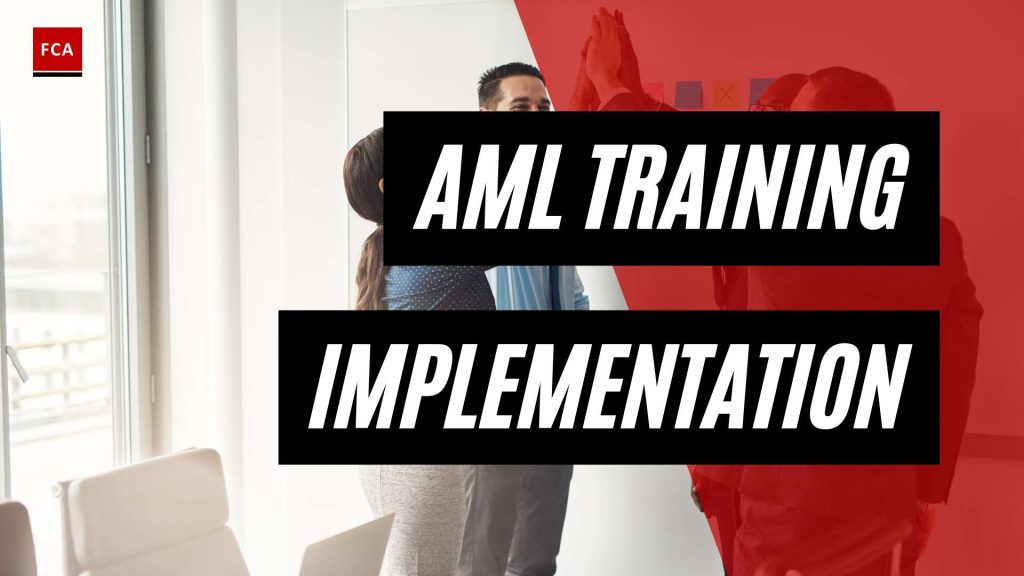Designing Effective AML Training Programs
When it comes to combating money laundering and ensuring compliance with anti-money laundering (AML) regulations, designing effective AML training programs is crucial. These programs are essential for educating employees on the importance of AML, their roles and responsibilities, and equipping them with the knowledge and skills necessary to detect and prevent money laundering activities. In this section, we will explore the importance of AML training and the significance of tailoring it to roles and responsibilities.
Importance of AML Training
AML training plays a pivotal role in creating a culture of compliance within organizations. It helps employees understand the significance of AML, the legal and regulatory framework surrounding AML compliance, and the potential risks associated with money laundering activities. By increasing awareness and knowledge, organizations can minimize the risk of being used for money laundering and protect themselves from severe financial, legal, and reputational consequences.
Furthermore, AML training programs cover a wide range of topics to ensure employees have a comprehensive understanding of their obligations. These topics include identifying suspicious activities, reporting requirements, customer due diligence, and the legal and regulatory framework surrounding AML compliance. By providing employees with a solid foundation of AML knowledge, organizations can enhance their ability to detect and report potential money laundering activities.
Tailoring AML Training to Roles and Responsibilities
To maximize the effectiveness of AML training, it is essential to tailor the training programs to the specific roles and responsibilities of individuals within the organization. Different departments and job functions may have varying levels of exposure to money laundering risks and different responsibilities in the AML compliance process.
By customizing the training content to align with specific job functions, organizations can ensure that employees receive relevant and targeted education on AML regulations, policies, and procedures. For example, employees in customer-facing roles may require training on customer due diligence and recognizing red flags, while those in compliance roles may need more in-depth knowledge on regulatory requirements and reporting obligations.
Tailoring AML training programs also allows organizations to address specific challenges and risks that may be unique to their industry or business model. By focusing on industry-specific scenarios and case studies, employees can better understand how money laundering can occur within their specific context and learn practical strategies to mitigate risks.
By recognizing the importance of AML training and customizing it to the roles and responsibilities of employees, organizations can ensure that their employees are equipped with the necessary knowledge and skills to contribute effectively to the AML compliance efforts. This proactive approach helps to minimize the risk of money laundering and strengthen the overall AML compliance program.
To learn more about effective AML training methods, AML training program design, and best practices in AML training, visit our articles on effective AML training methods, AML training program design, and AML training best practices.
In the next section, we will explore the key elements of AML training programs, including AML regulations and policies, identifying suspicious activities, and reporting obligations.
Key Elements of AML Training Programs
To effectively combat money laundering and meet regulatory requirements, implementing comprehensive Anti-Money Laundering (AML) training programs is essential. These programs equip individuals with the knowledge and skills necessary to identify and report suspicious activities. Key elements of AML training programs include understanding AML regulations and policies, identifying suspicious activities, and reporting obligations.
AML Regulations and Policies
AML training programs should provide an in-depth understanding of the legal and regulatory framework surrounding money laundering prevention. Participants should familiarize themselves with relevant legislation, such as the Bank Secrecy Act (BSA) in the United States, and understand the obligations imposed on financial institutions and other regulated entities.
By educating employees on AML regulations and policies, organizations ensure that individuals have a clear understanding of their responsibilities in preventing money laundering. Training should cover topics such as customer due diligence, know your customer (KYC) procedures, and the importance of monitoring and reporting suspicious transactions.
Identifying Suspicious Activities
One of the primary objectives of AML training is to enable individuals to identify and recognize suspicious activities. AML training programs should provide guidance on recognizing red flags that may indicate potential money laundering, such as unusual transaction patterns, inconsistent customer behavior, or transactions involving high-risk jurisdictions or individuals.
Through case studies, real-life examples, and interactive exercises, individuals can develop the skills needed to assess transactions and customer behavior critically. Training should focus on enhancing their ability to identify suspicious activities and escalate concerns to the appropriate internal departments or regulatory authorities.
Reporting Obligations
Reporting obligations are a critical aspect of AML training programs. Participants should be educated on their obligation to report suspicious transactions to the relevant authorities, such as the Financial Crimes Enforcement Network (FinCEN) in the United States. They should understand the importance of accurate and timely reporting and the potential consequences of failing to fulfill reporting obligations.
Training should provide clear guidance on the reporting process, including the necessary documentation and forms. It should emphasize the importance of maintaining confidentiality and protecting the identity of the reporting individual, as whistleblower protections may be in place.
By focusing on these key elements, AML training programs empower individuals with the knowledge and skills needed to effectively contribute to the prevention of money laundering. Organizations should ensure that their training programs are regularly updated to reflect changes in regulations, emerging risks, and best practices in the field. By doing so, they can maintain a strong AML compliance culture and protect their reputation while safeguarding the financial system.
Evaluating the Effectiveness of AML Training
To ensure the effectiveness of an AML training program, regular evaluations and testing should be conducted. This process helps assess employee understanding and knowledge of anti-money laundering (AML) requirements, enabling organizations to identify areas for improvement and ensure compliance with regulatory standards.
Assessing Employee Understanding
Evaluating employee understanding is a crucial component of measuring the effectiveness of an AML training program. Organizations can employ various methods to assess employee comprehension, including:
-
Knowledge Assessments: Conducting assessments such as quizzes or tests to evaluate employees’ understanding of AML regulations, reporting obligations, and other relevant topics. These assessments can be conducted periodically or after completing specific training modules.
-
Scenario-based Exercises: Presenting employees with real-life scenarios related to money laundering or suspicious activities and assessing their ability to identify and respond appropriately. This approach helps evaluate the practical application of AML knowledge.
-
Role-specific Assessments: Tailoring assessments to specific job roles within the organization to ensure employees receive targeted and relevant training based on their responsibilities and duties. This approach helps identify any gaps in knowledge specific to each role (Financial Crime Academy).
Testing and Evaluation Methods
To effectively evaluate the AML training program, organizations can utilize a range of testing and evaluation methods:
-
Written Assessments: Administering written exams or quizzes that cover key AML concepts, regulations, and reporting obligations. These assessments can be conducted online or in-person, depending on the organization’s training delivery methods.
-
Practical Exercises: Implementing practical exercises where employees are given real-world scenarios to analyze and respond to. This approach tests their ability to apply AML knowledge and make informed decisions in different situations.
-
Case Studies: Presenting employees with case studies that involve complex AML issues, requiring them to analyze the situation and propose appropriate actions. Case studies help employees develop critical thinking skills and apply AML principles in practical scenarios.
-
Observations and Role-Play: Observing employees in their day-to-day work activities to assess their adherence to AML policies and procedures. Role-playing exercises can also be used to simulate AML-related interactions, allowing for evaluation and feedback on employees’ performance.
Regularly evaluating the effectiveness of the AML training program enables organizations to identify gaps in knowledge, address any deficiencies, and enhance the overall training curriculum. It ensures that employees are equipped with the necessary skills and knowledge to recognize and report suspicious activities, meet reporting obligations, and contribute to the organization’s AML compliance efforts.
As organizations strive to maintain compliance with AML regulations, continuous evaluation and improvement of their training programs are essential. By regularly assessing employee understanding through various evaluation methods, organizations can strengthen their AML training initiatives and mitigate the risk of financial crime.
Ongoing AML Training and Education
In the ever-evolving landscape of combating money laundering and terrorist financing, continuous learning is of paramount importance. Organizations should invest in ongoing AML training programs to keep their employees informed about the latest developments and best practices in the field. This section will highlight the significance of continuous learning and the importance of keeping up with developments and best practices in AML.
Importance of Continuous Learning
Continuous learning is critical in the field of anti-money laundering (AML). As regulations, financial crime trends, and money laundering techniques evolve, it is crucial for professionals working in compliance, risk management, anti-money laundering, and anti-financial crime roles to stay updated. Ongoing AML training ensures that employees are equipped with the necessary knowledge and skills to adapt to these changes, detect emerging risks, and implement effective preventive measures.
Continuous learning also helps organizations meet regulatory requirements. Regulators expect financial institutions to provide regular AML training to their employees to ensure compliance with AML regulations. By investing in ongoing AML training programs, organizations demonstrate their commitment to maintaining a robust AML compliance program and protecting themselves from potential legal and reputational risks.
Keeping Up with Developments and Best Practices
Keeping up with developments and best practices in AML is essential for professionals in the field. It is crucial to stay informed about changes in regulations, new typologies of money laundering, and emerging trends in financial crime. By staying up-to-date, professionals can effectively identify and mitigate risks, implement appropriate controls, and contribute to the overall effectiveness of their organization’s AML program.
To facilitate ongoing AML training and education, organizations can leverage various resources. AML training programs offered by the Financial Crime Academy provide a range of delivery methods, including online courses, in-person workshops, webinars, and customized training modules. This flexibility allows organizations to tailor their training approach to meet specific needs and preferences.
Additionally, industry associations and regulatory bodies often provide resources and guidance on best practices in AML. Professionals can access these resources to stay informed about the latest developments, learn from case studies and real-world examples, and enhance their understanding of AML requirements and expectations.
By prioritizing ongoing AML training and education, professionals and organizations can strengthen their knowledge base, improve their ability to detect and prevent money laundering, and contribute to the overall integrity of the financial system.
In the next section, we will explore the AML training programs offered by the Financial Crime Academy, covering the topics covered in the training and the delivery methods available.
Keep learning and stay ahead in the fight against money laundering!
AML Training Programs Offered by Financial Crime Academy
The Financial Crime Academy is dedicated to providing comprehensive and effective Anti-Money Laundering (AML) training programs for employees, designed to comply with regulatory requirements and industry standards. These training programs equip staff with the necessary skills and knowledge to combat financial crime effectively. By partnering with the Financial Crime Academy, organizations can ensure that their employees receive top-notch AML training.
Topics Covered in AML Training
The AML training programs offered by the Financial Crime Academy cover a wide range of essential topics. These programs are designed to provide employees with a comprehensive understanding of AML concepts and equip them with practical skills to identify and prevent money laundering activities. Some of the key topics covered in the training programs include:
- Identification of money laundering risks
- Understanding the regulatory environment and AML laws
- Recognizing suspicious activities and red flags
- Reporting obligations to relevant authorities
- Customer due diligence and Know Your Customer (KYC) procedures
- AML program implementation and compliance measures
By addressing these critical topics, employees gain a deep understanding of AML principles and develop the necessary expertise to effectively combat money laundering within their respective roles and responsibilities.
Delivery Methods for AML Training
The Financial Crime Academy recognizes the importance of offering flexible and accessible training options. Their AML training programs can be delivered through various formats, allowing organizations to choose the most suitable method for their employees. The delivery methods include:
-
Online courses: These self-paced, interactive online courses provide employees with the flexibility to complete their training at their own convenience. Online courses offer engaging content, quizzes, and assessments to ensure effective learning.
-
In-person workshops: For organizations seeking a more hands-on approach, the Financial Crime Academy offers in-person workshops facilitated by experienced trainers. These workshops provide opportunities for interactive discussions, case studies, and practical exercises.
-
Webinars: Webinars offer a convenient way to deliver AML training to a large audience. These live online sessions provide interactive learning experiences, allowing participants to engage with trainers and ask questions in real-time.
-
Customized training modules: The Financial Crime Academy also offers the flexibility to develop customized training modules tailored to the specific needs of an organization. These modules can be designed to address unique AML challenges and align with an organization’s policies and procedures.
By offering a variety of delivery methods, the Financial Crime Academy ensures that organizations can choose the most effective and convenient way to deliver AML training to their employees, maximizing engagement and knowledge retention.
Through their comprehensive AML training programs, the Financial Crime Academy empowers employees with the skills and knowledge needed to detect, prevent, and report money laundering activities effectively. By partnering with the Financial Crime Academy, organizations can enhance their AML compliance efforts and foster a strong culture of awareness and vigilance in combating financial crime.
Case Study: Importance of AML Training for Financial Companies
In the ever-evolving landscape of financial crime prevention, implementing effective AML (Anti-Money Laundering) training programs is crucial for financial companies. AML training provides employees with the knowledge and skills necessary to understand the significance of AML, the legal and regulatory framework surrounding it, and how to identify and report suspicious activities. This training is designed to minimize the risk of financial institutions being used as conduits for money laundering activities (Medium).
Consequences of Non-Compliance
The importance of AML training becomes evident when considering the consequences of non-compliance. Financial companies that fail to establish and adhere to robust AML training programs can face severe repercussions. For instance, in 2020, Goldman Sachs was involved in a bribery scheme that resulted in a record-breaking $2.9 billion fine paid to anti-money laundering regulators (Medium).
Non-compliance with AML regulations can lead to reputational damage, financial losses, and legal actions. Companies that neglect to implement proper AML training risk damaging their standing in the industry and losing the trust of clients and stakeholders. Financial penalties can be hefty, potentially reaching thousands of dollars, and individuals responsible for non-compliance may face imprisonment for up to 20 years (Medium).
Protecting Reputation and Customers’ Trust
In addition to the financial and legal implications, AML training plays a crucial role in safeguarding the reputation of financial companies. By equipping employees with the knowledge and skills to detect and report suspicious activities, organizations can maintain the trust of their customers and stakeholders.
Customers expect financial institutions to have robust systems in place to prevent money laundering. When companies demonstrate a commitment to AML training, it instills confidence in customers that their funds are being managed responsibly and ethically. By actively working to prevent money laundering, financial institutions show that they prioritize the security and integrity of their customers’ financial transactions.
Protecting reputation and customers’ trust is paramount in an industry where trust and integrity are foundational. AML training empowers employees to play an active role in maintaining the integrity of financial systems, thereby upholding the reputation of the company and building strong relationships with clients.
By recognizing the consequences of non-compliance and emphasizing the importance of AML training, financial companies can establish a culture of compliance and ensure that their employees are equipped with the knowledge and skills necessary to detect and report suspicious activities. Implementing effective AML training programs not only helps organizations meet legal and regulatory requirements but also protects their reputation and the trust of their customers.
Requirements and Stages of AML Training Implementation
To ensure the effectiveness of anti-money laundering (AML) training programs, it is important to understand the requirements and stages involved in their implementation.
AML Training Requirements
AML training requirements can vary based on company size, industry, and location. In the United States, AML training is typically mandated for financial institutions and their employees under the Bank Secrecy Act (BSA) and its implementing regulations (Medium).
Reporting entities are required to develop and maintain a written, ongoing compliance training program for employees, agents, or other authorized individuals. The training program should cover the requirements of the applicable regulations and legislation relevant to their duties and positions. Training should be delivered at regular intervals or when certain events occur to ensure that employees stay up to date with the latest AML regulations and best practices (FINTRAC).
Stages of AML Training Implementation
The implementation of AML training programs typically involves several stages to ensure comprehensive coverage and successful knowledge transfer.
-
Identify Training Needs: The first stage is to identify the individuals within the organization who require AML training. This typically includes employees who handle customer accounts, process transactions, or are involved in compliance-related roles. By identifying the specific roles and responsibilities that require training, organizations can tailor their training programs accordingly.
-
Develop Training Plan: Once the training needs have been identified, a training plan should be developed. The plan should outline clear objectives, topics to be covered, and the desired learning outcomes. It is important to design a curriculum that addresses the specific AML risks and regulations applicable to the organization. For guidance on designing an effective training curriculum, refer to our article on designing AML training curriculum.
-
Delivery Methods: A variety of delivery methods can be used for AML training, such as classroom training, e-learning modules, webinars, or a combination of these. The choice of delivery method should consider the organization’s size, budget, and the accessibility of employees. Utilizing a mix of delivery methods can help accommodate different learning preferences and ensure maximum engagement.
-
Evaluate Employee Understanding: After the training has been delivered, it is crucial to assess the employees’ understanding of the material. This can be done through evaluations, quizzes, or assessments. Evaluations should cover key topics, regulatory requirements, and the organization’s internal policies and procedures. For guidance on evaluating the effectiveness of AML training, refer to our article on AML training program evaluation.
-
Ongoing Training and Updates: AML training should not be a one-time event. It is important to establish a culture of continuous learning and keep employees up to date with developments in AML regulations and best practices. Regular refresher training sessions and updates should be provided to reinforce knowledge and ensure that employees remain vigilant in detecting and preventing money laundering activities. For more information on the importance of continuous learning, refer to our article on the importance of continuous learning.
By following these stages of AML training implementation, organizations can effectively educate their employees on AML regulations and equip them with the necessary knowledge and skills to detect and report suspicious activities. This helps create a strong compliance culture and reduces the risk of non-compliance, protecting both the organization’s reputation and customers’ trust.
Elements of an Effective AML Compliance Program
To effectively combat money laundering and terrorist financing, organizations need to establish and implement comprehensive Anti-Money Laundering (AML) compliance programs. These programs consist of various elements that work together to ensure regulatory compliance and mitigate financial crime risks. Three key elements of an effective AML compliance program are the compliance officer and resources, AML compliance policies and controls, and training programs and audits.
Compliance Officer and Resources
A crucial component of an effective AML compliance program is the appointment of a designated compliance officer. This individual is responsible for overseeing the organization’s compliance efforts, ensuring adherence to AML regulations, and reporting suspicious activities to the relevant authorities. According to FINTRAC, the compliance officer should have independent oversight and be able to communicate directly with senior management or the board of directors.
In addition to a competent compliance officer, organizations must allocate adequate resources to support the compliance program. This includes providing sufficient staffing, technology, and training to effectively detect, prevent, and report potential instances of money laundering and terrorist financing. By dedicating appropriate resources, organizations can strengthen their ability to identify and mitigate risks associated with financial crime.
AML Compliance Policies and Controls
AML compliance policies and controls form the foundation of an effective AML compliance program. These policies and controls should cover a range of requirements, including client identification, reporting obligations, record keeping, and risk assessment. The level of detail in these policies and procedures will depend on the size, structure, complexity, and degree of exposure to money laundering/terrorist financing risks of the organization (FINTRAC).
By establishing comprehensive policies and controls, organizations can ensure that employees understand their responsibilities and follow standardized procedures to detect and report suspicious activities. Regularly reviewing and updating these policies and controls is essential to keep pace with evolving regulations and emerging financial crime trends. This ongoing commitment to compliance helps organizations stay ahead of potential risks and maintain the integrity of their operations.
Training Programs and Audits
An effective AML compliance program includes robust training programs and regular audits to ensure employees are equipped with the knowledge and skills needed to fulfill their AML obligations. Reporting entities must develop and maintain a written, ongoing compliance training program that covers the requirements of the applicable AML laws and regulations (FINTRAC).
Training programs should be tailored to the specific roles and responsibilities of employees, agents, or other authorized individuals. These programs should provide comprehensive guidance on AML regulations, suspicious activity identification, reporting obligations, and best practices for mitigating financial crime risks. Training should be delivered at regular intervals and when certain events occur, ensuring that employees remain up-to-date with the latest AML requirements and techniques.
Regular audits and assessments of the AML compliance program are essential to evaluate its effectiveness and identify areas for improvement. These audits help organizations identify any gaps or weaknesses in their processes and controls, allowing them to take corrective actions and enhance their overall compliance posture.
By focusing on these key elements, organizations can establish and maintain effective AML compliance programs that meet regulatory requirements and effectively combat money laundering and terrorist financing risks. Implementing a comprehensive compliance program not only protects the organization from the consequences of non-compliance but also safeguards its reputation and the trust of its customers.








